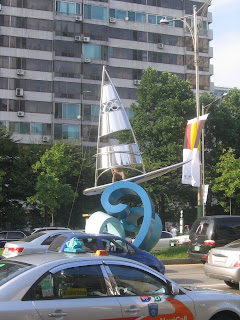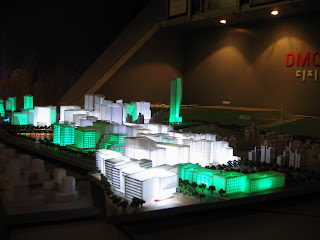Now, twenty years later, as we embark upon the task of outlining possible futures for Beijing, China, Asia, and parts of the world, I was fortuitously afforded the chance to go to Seoul. In gathering visual evidence of the living remains of the Olympic festival of 88, and exploring the metropolis of Seoul for various indicators of cultural, economic, and political health, I was able to glean only the quickest and dirtiest of opinions. However, the significance of Seoul as a possible pointer for the cultural, technological, and demographic trends of greater Asia, may lend foundational support for some of the Future Scenarios stemming from the Beijing Games and the research of this project.

The Olympic Highway and Lotte World
Unfortunately, I wasn't able to make it all the way to the official Olympic Village of the '88 games. Along the road to what would have been a goldmine of theoretical tangents for my research, the median is lined with the national flags of the participating nations. Various tribute sculptures remain-- well kept despite being surrounded by a 6 lane urban highway. Most likely, the timing of my visit allowed me to see this section of Olympic Highway in a high state of floral decoration, and cleanliness. Though other aspects of the city would just as easily lead me to believe that this avenue always looks so well maintained.



These photos were snapped just outside the gates of the famous Lotte World, a huge complex including a high end shopping mall, a Korean Folk Museum, Lotte Luxury Hotel, and an amusement park with both indoor and outdoor components. The official opening of the Lotte World Adventure Park was in 1989, making much of its construction congruent with the Olympic Games, and most likely a major hub for post-Olympic, peripheral development in the area.
Boasting a massive indoor amusement park, with roller coasters, theme rides, indoor ice-skating rink, and a elevated tram, the Lotte World Adventure is as much a testament to state-of-the-art construction for its time as it is a fun place to go. Is it likely that similar installations will go into development at the close of the Beijing Games? Does the new National Forest Park, a huge swath of (relatively central) Beijing that has been set aside as green space represent not only a more expensive venture, but also a testament to China's commitment to "green"? For now we can only speculate, but my opinion is that both may turn true, and indoor amusement on a scale as grand as this is soon to follow.


In downtown Seoul, a red and blue, spiral pinnacle marks the emergence of the Cheonggyecheon River. Installed at the gateway of Seoul's downtown Olympic Park, the river now has a dual role in the cities urban art --standing as a tribute to the Games and other important events that have been hosted by the city, and also as a social center for festivals, markets, and, at night, the cities youth.


For a majority of its trek down-stream, the Cheonggyechong is kept shallow, and border by steps for sitting and resting one's tired feet in the cool water. It's clean appearance, and safe atmosphere are maintained by the city, and some private volunteers. What remnants of art, culture, and social ideology will remain for the Beijing Olympic sites? Were Seoul's city planners aware that the river would be a mecca for the myriad of Seoul's youth who stumble down to the river for a good foot soaking?
By looking at Seoul from a demographic stance, it is more likely that the fate of this small downtown stream was well planned and orchestrated by the Urban Design teams responsible for creating the urban world that more than half of South Korea now calls home. Indeed, the National Capital Area, including Seoul, Incheon, and the greater metropolitan area, is home to nearly 26 million people, and its population continues to grow, placing it among the highest human populated areas on the planet.
 As Beijing grows quickly towards the 20 million mark in population, and other urban centers of China meet and eclipse that same figure, massive shifts will occur, and urban designers and planning teams will be forced to push the limits of their creativity and foresight. Watching peers cities like Seoul, Tokyo, Singapore, and Hong Kong, mainland PRC's urban centers will be keen to maximize efficiency of all resource consumption, transportation, and growth patterns. Increasing the pervasiveness of communications technologies, alternative energies, and integrated medias will also be of high importance, and installations like the Digital Media City in Seoul (opening in 2010), could likely be a significant working example of "ubiquitous" society.
As Beijing grows quickly towards the 20 million mark in population, and other urban centers of China meet and eclipse that same figure, massive shifts will occur, and urban designers and planning teams will be forced to push the limits of their creativity and foresight. Watching peers cities like Seoul, Tokyo, Singapore, and Hong Kong, mainland PRC's urban centers will be keen to maximize efficiency of all resource consumption, transportation, and growth patterns. Increasing the pervasiveness of communications technologies, alternative energies, and integrated medias will also be of high importance, and installations like the Digital Media City in Seoul (opening in 2010), could likely be a significant working example of "ubiquitous" society.The DMC project is being hailed by the Korean government as a "'futuristic city center'[that] will function as the test-bed and hub of the digital media industry focusing on movie, broadcasting, animation, music, and online-education." With sponsorship by some major corporations like Woori Bank, LG CNS and LG Telecom, Korea Electronics Association, PANTECH, KBS Media, and the Munhwa Broadcasting Corporation it may turn out that these claims are conservative. I will briefly discuss some of the major portions of the DMC concept, but I highly advise any visitors to go to the main website for further exploration.
The Digital Media Street (DMS) will run the entire length of the DMC and offer a number of novel technological advances in invisible and ubiquitous personal communications and media availability. From high-speed wireless (capable of seamless HD streaming), to HUD social-profiles for other pedestrians on the street, embedded lights that respond to both the environment and the individual, and animated tour guides, the DMS will be a unique amalgamate of the latest stage of wireless immersive technologies. Whether or not the idealized experience, and the actual experience compare to one another is quite another story, and we will visit again in the future to test usability, novelty, and impressions.
The "Eco-friendly" terminology has been heavily employed by the public relations department, and the evidence of this puh can be seen in a few technologies integrated into the design plans. For instance, the land on which the DMC will sit is a reclaimed landfill that has been turned into an "eco-park," and eco-friendly housing is touted as the best way to " achieve eco-friendly development and create technology that puts man first." Truly, a claim of the highest moral intentions. Specific examples of eco-friendly technologies employed in the creation of the housing units, the eco-park, and the massive glass and steel facilities have yet to be fully released.


Seoul, 2008, 20 years after it played host to the world for 17 days of athletic competition is in many ways thriving. The Korean Culture Wave is sweeping across East Asia, and installations like the DMC are being built to ensure that influence remains cutting edge. The population of the National Capital Area, and the standard of living that they enjoy, continues to increase. And the '88 Olympic Motto "Harmony and Progress," may well be viewed as poetry in motion.
